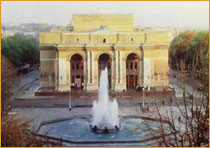|
> Author unknown The end of the twenties in Uzbekistan witnessed the beginning of a complicated process of emerging of a new genre of a music theatre and its supreme form for the Uzbek art - the national opera and ballet. Folk traditions in music and dance were the basis of the process and its creators of new forms in art were talented musicians, actors, singers and dancers who stepped from amateur stage to professional art and became its founders in Uzbekistan.
The beginning was in 1926 when the first national ethnographic ensemble headed by Mukhitdin Kari-Yakubov was set up. This collective not only trained young artists and gathered and performed folk melodies and dances in concerts but it also started to perform whole musical pieces like Arshin Mal Alan by U. Gadjibekov, Rizavarchi by A. Kamarlinsky, Khalim by G. Zafari.When the theatre repertoire was created the ensemble was transformed into a professional theatre and since 7 November 1929 became known as the Uzbek State theatre. The young theatre was actively involved in creating original musical pieces and training actors with professional vocal technique and actor's skills. The artists of the theatre were: Mukkaram Turgunbaeva, Roziya Karimova, Isakhar Akilov, Gulyam Abdurakhmanova, Sagdulla Djurabaev, later Karim Zakirov, Lutfukhanum Sarimsakova, Nazira Akhmedova, Shakhodat Rakhimova. One of the first successes of the theatre was the musical drama Leili and Mejnun staged in 1933 and based on A. Navoi's poem and libretto by Khurshid. The music of the performance consisted of folk melodies arranged by T. Sadikov. Other shows like Farkhad and Shirin and Gulsara were created following the same principle of using folk melodies and dances. A further step in the development of professional musical art was the creation of opera and transfer from the musical theatre to the theatre of opera and ballet. Mastering the complicated genre of opera the young theatre first staged the opera Yor Targin by Ye. Brusilovsky and Nargiz by Azerbaijanian composer M. Magomaev. The accumulated experience allowed the theatre to start producing Uzbek operas. The premiere of the first national Uzbek opera Buron composed by M.Ashrafi and S. On 17 June 1939 the State Uzbek musical theatre was renamed into the State Uzbek theatre of opera and ballet. The theatre has traversed a complicated creative path setting up a national and classical repertoire and discovering the great world musical legacy. The theatre's repertoire included such national operas as Ulugbek, Dilorom, ballets The Ballerina, The Dream as well as classical operas and ballets such as Carmen and The Fountain of Bakhchisarai. As of March 1948 the Uzbek opera theatre merged with the Russian opera theatre and became known as the A. Navoi State theatre of opera and ballet. During the years of its existence until the end of the XX century this theatre has produced on its stage 356 premiere opera and ballet productions. More than six million people have visited the theatre. For its great successes in developing the opera and ballet art the theatre was awarded the title Academic in 1959 and in 1966 the title of Bolshoi which moved it into the big league of Soviet Ballet companies.
home | introduction | articles
Copyright © 2004
All Rights Reserved.
|
|


